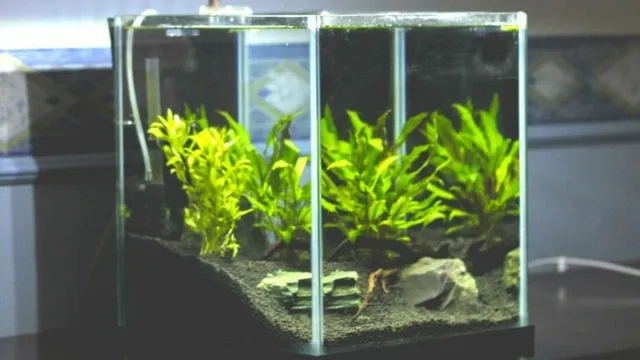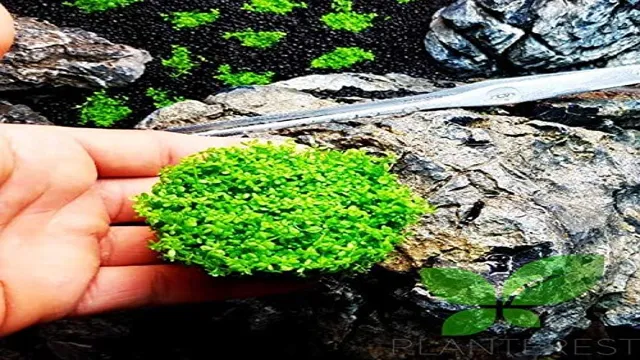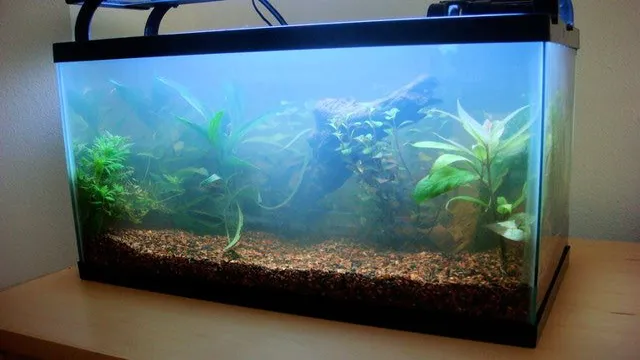Do you love keeping aquarium plants but find that they just won’t stay down? Are they constantly floating to the surface and causing a mess in your tank? Don’t worry, you’re not alone! Many aquarium enthusiasts struggle with this issue, but luckily, there are some tips and tricks that can help keep your plants down where they belong. It can be frustrating to spend time and money on beautiful aquatic plants, only to have them constantly floating to the surface. But fear not, there are a few things you can do to keep them in place.
Whether you’re a beginner or a seasoned aquarist, these tips will help you achieve a luscious and healthy underwater garden. From choosing the right type of gravel to using weights and fishing line, we’ve compiled a list of helpful tricks to keep your aquarium plants rooted in place. We’ll also explore the importance of providing adequate lighting and nutrients for your plants to thrive.
So, grab a cup of coffee, sit down, and get ready to learn some helpful tips and tricks for keeping your aquarium plants down where they belong. With a little effort and patience, you’ll have a beautiful and healthy aquatic garden in no time!
Introduction
Keeping aquarium plants down can be a challenge for many aquarium hobbyists, especially when they have fast-growing plants that need frequent trimming. So, how can you keep your aquarium plants under control without harming them? One of the best ways to do this is by using the right tools to trim your plants. A pair of sharp scissors or pruning shears will allow you to make precise cuts without damaging the plant.
Additionally, you can also use plant weights or plant anchors to hold your plants in place. These will prevent the plants from floating to the surface and becoming tangled. Lastly, it’s important to maintain a regular trimming schedule to prevent plants from getting too big and overflowing the tank.
By following these simple steps, you can keep your aquarium plants healthy and looking their best.
Why Do Plants Float?
Plants have a unique characteristic of floating on water, which often leaves us wondering why they do so. Well, the answer is quite simple – plants float due to their buoyancy. Buoyancy is a property that allows an object to float on water, and this is due to the fact that the object is less dense than water.
This phenomenon is similar to the way a balloon filled with helium rises in the air. Plants have air pockets within them, which make them less dense than water. These air pockets are located in the leaves, stems, and other parts of the plant, enabling them to float effortlessly on the surface of the water.
Hence, buoyancy plays a crucial role in making plants float.

Benefits of Keeping Plants Down
When it comes to home decor, plants have become a staple. They’re natural, aesthetically pleasing, and bring life to any space. But did you know that keeping plants down has numerous benefits? Not only do they freshen up the air and improve the quality of life, but they can also boost productivity, reduce stress, and improve mental health.
And the best part is that they require minimal effort to care for. So, whether you’re looking to spruce up your space or improve your well-being, adding a few plants to your environment can make a significant difference.
Factors Contributing to Floating Plants
Aquarium plants provide many benefits to the overall health and appearance of a tank, but sometimes they can become a nuisance by floating to the surface. There could be a variety of factors contributing to this issue. For example, inadequate lighting and CO2 levels could cause certain plants to float up towards the surface.
Additionally, overcrowding and lack of nutrients can also result in plants becoming buoyant. To combat this problem, aquarium owners can implement several tactics, such as pruning and providing ample lighting and nutrients to the plants. Additionally, using plant weights or aquarium-friendly adhesive can also help keep plants in place. (See Also: How to Apply Reptile Hooks on Screened Aquarium Like a Pro)
With these strategies in mind, keeping aquarium plants down can become a manageable task and allow for a beautiful and flourishing aquatic environment.
Lighting
Lighting When it comes to floating plants, there are a number of factors to consider. One of the most important is lighting. Without proper lighting, these plants can’t photosynthesize effectively, which can lead to inadequate growth and even death.
There are a few different factors that contribute to the ideal lighting conditions for floating plants. The first is the intensity of the light. Too much or too little light can both cause problems, so finding the right balance is key.
The duration of the light cycle is also important, as floating plants need a certain amount of exposure to light each day to thrive. Finally, the color temperature of the light can influence plant growth and development. Choosing the right light bulb or adjusting the color temperature of your existing lighting can make a big difference in the health of your floating plants.
With the right lighting conditions in place, these unique and fascinating plants can bring a touch of natural beauty to any aquatic environment.
Nutrients
Nutrients There are a few factors that contribute to the growth and survival of floating plants, such as water depth, temperature, and sunlight. One of the most critical factors is nutrients. Floating plants rely heavily on nutrients, such as nitrogen and phosphorus, to thrive.
These nutrients can come from various sources, including surrounding vegetation, animal waste, and decaying organic matter. However, excess nutrients can also lead to the overgrowth of algae and other aquatic plants, which can negatively affect floating plant populations. It’s essential to maintain a balance of nutrients in the water to support healthy floating plant growth and avoid eutrophication, a process where nutrient levels become too high, causing blooms of algae and other plants that can lead to oxygen depletion and harm aquatic life.
By managing nutrient levels effectively, we can promote the growth and sustainability of floating plants and maintain a healthy aquatic ecosystem.
CO2 Levels
Floating plants are a beautiful addition to any water feature, but what factors contribute to their growth? One major factor is the level of carbon dioxide (CO2) in the water. Floating plants, like all plants, need CO2 for photosynthesis, the process by which they create their own food. Without enough CO2, the plants will struggle to survive and may begin to wither away.
In addition to natural CO2 levels in the water, the amount of sunlight and temperature of the surrounding environment also play a role in the growth of floating plants. If you want to encourage the growth of floating plants in your pond or water garden, make sure to provide plenty of natural light and maintain a consistent temperature. By doing so, you’ll create a thriving environment for these lovely aquatic plants to flourish and add beauty to your water feature.
Methods to Keep Plants Down
Keeping aquarium plants down can be challenging, but there are several methods to achieve this. One way is to use rocks or weights specifically designed for aquariums to anchor the plants down. This method can be effective, but it may not be the most aesthetically pleasing option. (See Also: How to Get Rid of Aquarium Snail: Tips and Tricks for a Cleaner Tank)
Another method is to use a substrate that naturally keeps the plants rooted, such as sand or gravel. This not only keeps the plants down but also provides essential nutrients for their growth. Additionally, trimming the plants regularly can help keep them at a manageable height and prevent them from floating to the surface.
Another alternative is to use plant anchors, which are small plastic clips that you can attach to the plant’s stem to keep them rooted. Overall, keeping aquarium plants down requires a bit of effort, but it is essential for maintaining a healthy and thriving aquatic environment.
Plant Weights
Plant weights are an incredibly useful tool for keeping plants down and protecting them from harsh winds or other hazards. One effective method to keep plants down is simply to place rocks or other heavy objects on top of the soil around the base of the plant. This not only helps to keep the plant in place, but it also provides added stability to the soil and helps to retain moisture.
Another useful method involves using stakes or poles to support the plant, allowing it to grow upward while still remaining secure and stable. Plant weights can also be used in conjunction with other methods such as netting or cages, providing even greater protection for your plants. Overall, if you are looking to keep your plants healthy and thriving, incorporating plant weights into your garden maintenance routine is definitely worth considering.
Plant Anchors
Trying to grow plants in a garden or a pot can be a tricky task, especially when the foliage doesn’t want to stay in its place. Plant anchors are the perfect solution to this problem. There are plenty of methods to keep plants down, including using heavy rocks, garden staples, or wire pins.
These anchors work by physically keeping the plant in place, deterring wind or other environmental factors from dislodging the roots. Additionally, plant anchors keep seedlings from being disturbed by hungry critters and small children. It’s easy to forget about the necessity of keeping plants in place, but by using plant anchors, you can ensure proper growth and longevity for your favorite plants.
Sand or Gravel Substrate
When it comes to choosing between sand or gravel substrates for your aquarium, there are positives and negatives to both. While sand may be visually appealing and easier to clean, it can be tricky to keep rooted plants anchored down. Gravel, on the other hand, may initially seem like the better option for planting, but it can provide a challenge to get any plants to stay put.
However, there are a few methods you can try to help keep your plants rooted in place, regardless of substrate choice. One popular method is to use plant weights, such as lead or ceramic weights, which attach directly to the roots of the plant. Another technique is to utilize plant-specific adhesives that will help to keep the roots anchored to the substrate.
Additionally, you can try using small rocks or nylon mesh to trap the roots and keep them from floating away. With a bit of experimentation and patience, you can find the right method that works for you and your aquarium plants.
Liquid CO2 Supplements
If you’re looking for ways to keep your plants down, liquid CO2 supplements could be the solution for you. These supplements are a popular choice among plant enthusiasts as they can help prevent the growth of unwanted plants by providing essential nutrients that plants need in order to thrive. By supplementing your plants’ nutrient intake with liquid CO2, you can ensure that they have the necessary resources to grow while preventing the overgrowth of other unwanted plants.
Additionally, liquid CO2 supplements are easy to use and can be integrated seamlessly into your plant care routine. By incorporating liquid CO2 supplements into your plant care routine, you can help your plants stay beautiful and healthy while keeping them under control.
Conclusion
In summary, keeping aquarium plants down is all about finding the right balance between their growth and maintenance. It requires consistent pruning, fertilization, and lighting, as well as ensuring that they have the proper space and substrate to grow in. Just like any other plant, the key is to give them what they need to thrive without letting them take over. (See Also: How to Prepare Manzanita for Aquarium: A Step-by-Step Guide)
With some patience and attention to detail, you can create a beautiful aquatic paradise that both you and your aquatic plants can enjoy!”
FAQs
What are some tips for keeping aquarium plants from floating to the surface?
To keep aquarium plants down, try adding a layer of substrate such as sand or gravel to hold the plants in place. You can also attach plants to rocks or driftwood with fishing line or plant anchors.
How often should I prune my aquarium plants to keep them from getting too tall?
It’s recommended to trim aquarium plants every 4-6 weeks to prevent them from growing too tall. Use a pair of sharp scissors and cut just above a leaf node.
Can I use fertilizers to help keep my aquarium plants down?
Yes, fertilizers can help provide the nutrients that aquarium plants need to grow healthy and strong. Look for a fertilizer specifically designed for aquarium use and follow the instructions carefully.
What types of aquarium plants are best for staying low to the ground?
Some good options for low-growing aquarium plants include Java moss, Anubias nana, and Dwarf Hairgrass. Be sure to research the specific care requirements for each plant.
Can lack of light cause aquarium plants to float to the surface?
Yes, inadequate light can cause aquarium plants to grow tall and float to the surface in search of better light. Make sure your aquarium has the appropriate lighting for the plants you have.
Should I use CO2 to keep my aquarium plants down?
Adding CO2 to your aquarium can help aquarium plants grow faster and stronger, but it’s not necessary for keeping them down. If you choose to use CO2, be sure to research and follow the appropriate safety measures.
Can overcrowding in an aquarium cause plants to grow too tall and float to the surface?
Yes, overcrowding in an aquarium can lead to limited space and resources for plants, causing them to grow too tall and float to the surface. Be sure to properly maintain your aquarium and avoid overstocking.






